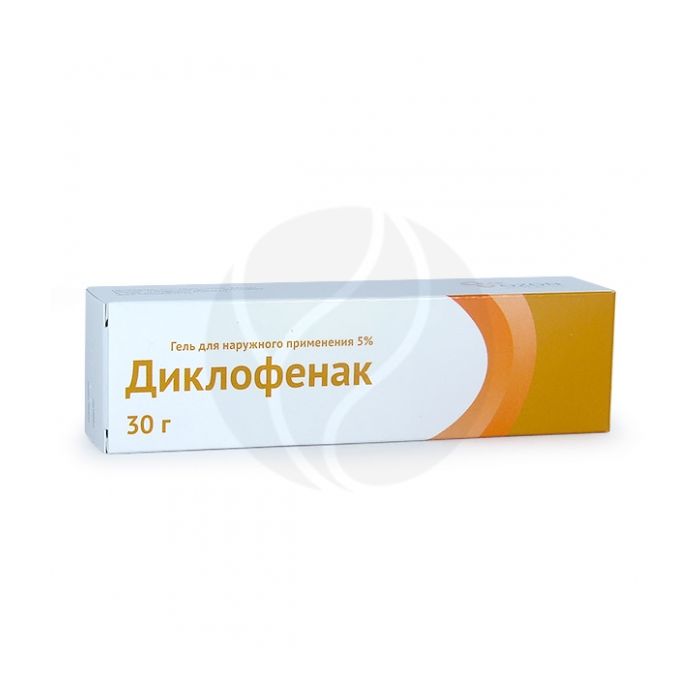Diclofenac gel 5%, 30 g
Expiration Date: 11/2025
Russian Pharmacy name:
Диклофенак гель 5%, 30 г
Post-traumatic inflammation of soft tissues and joints, for example, as a result of sprains, strains and bruises;
rheumatic diseases of soft tissues (tendovaginitis, bursitis, damage to the periarticular tissues);
pain syndrome and swelling associated with diseases of muscles and joints (rheumatoid arthritis, osteoarthritis, radiculitis, lumbago, sciatica, muscle pain of rheumatic and non-rheumatic origin).
Outwardly. For adults and children over 12 years old, the drug is applied in a thin layer over the focus of inflammation 3-4 times / day and rubbed lightly. The required amount of the drug depends on the size of the painful area. A single dose of the drug is 2-4 g (by volume comparable to the size of a large cherry).
After applying the drug, wash your hands.
The duration of treatment depends on the indications and the observed effect. After 2 weeks of using the drug, you should consult your doctor.
Diclofenac sodium 1 g
Excipients: ethanol (rectified ethyl alcohol) - 25 g, propylene glycol - 5 g, carbomer 940 (carbopol 980) - 0.9 g, diethanolamine - 1 g, liquid paraffin (vaseline oil) - 2.5 g, cocoil caprilocaprate - 2.5 g, macrogol cetostearate (macrogol 20 cetostearyl ether) - 2 g, lavender oil - 0.05 g, orange blossom oil (neroli oil) - 0.05 g, purified water - up to 100 g.
Anamnestic data about an attack of bronchial obstruction, rhinitis, urticaria after taking acetylsalicylic acid or other NSAIDs;
pregnancy (III trimester);
lactation period;
children under 12 years of age;
violation of the integrity of the skin;
hypersensitivity to diclofenac or other components of the drug, to acetylsalicylic acid or other NSAIDs.
Carefully
Hepatic porphyria (exacerbation), erosive and ulcerative lesions of the gastrointestinal tract, severe liver and kidney dysfunction, chronic heart failure, old age, bronchial asthma, pregnancy (I and II)
Pharmacodynamics
The active ingredient diclofenac is a non-steroidal anti-inflammatory drug (NSAID) with pronounced analgesic and anti-inflammatory properties. By indiscriminately inhibiting type 1 and 2 cyclooxygenase, it disrupts the metabolism of arachidonic acid and the synthesis of prostaglandins, which are the main link in the development of inflammation. Diclofenac-Acri is used to relieve pain and reduce swelling associated with the inflammatory process. When applied topically, it causes relief or disappearance of joint pain at rest and during movement. Reduces morning stiffness and swelling of the joints, increases range of motion.
Pharmokinetics
When applied topically, systemic absorption is no more than 6%. When applied to the area of ??the affected joint, the concentration in the synovial fluid is higher than in the plasma.
Side effects
Local reactions: eczema, photosensitivity, contact dermatitis (itching, redness, swelling of the treated skin area; papules, vesicles, peeling). Systemic reactions: generalized skin rash, allergic reactions (urticaria, angioedema, bronchospastic reactions).
Special conditions
The gel should only be applied to intact skin, avoiding contact with open wounds. After application, do not apply an occlusive dressing. Do not allow the drug to come into contact with the eyes and mucous membranes. When using the drug in conjunction with other dosage forms of diclofenac, the maximum daily dose should be taken into account. When applied to large skin surfaces for a long time, the risk of developing systemic side effects characteristic of NSAIDs increases.
Overdose
The extremely low systemic absorption of the active components of the drug when applied externally makes an overdose almost impossible.
Drug interactions
The drug can enhance the effect of drugs that cause photosensitization. No clinically significant interactions with other drugs have been described.

